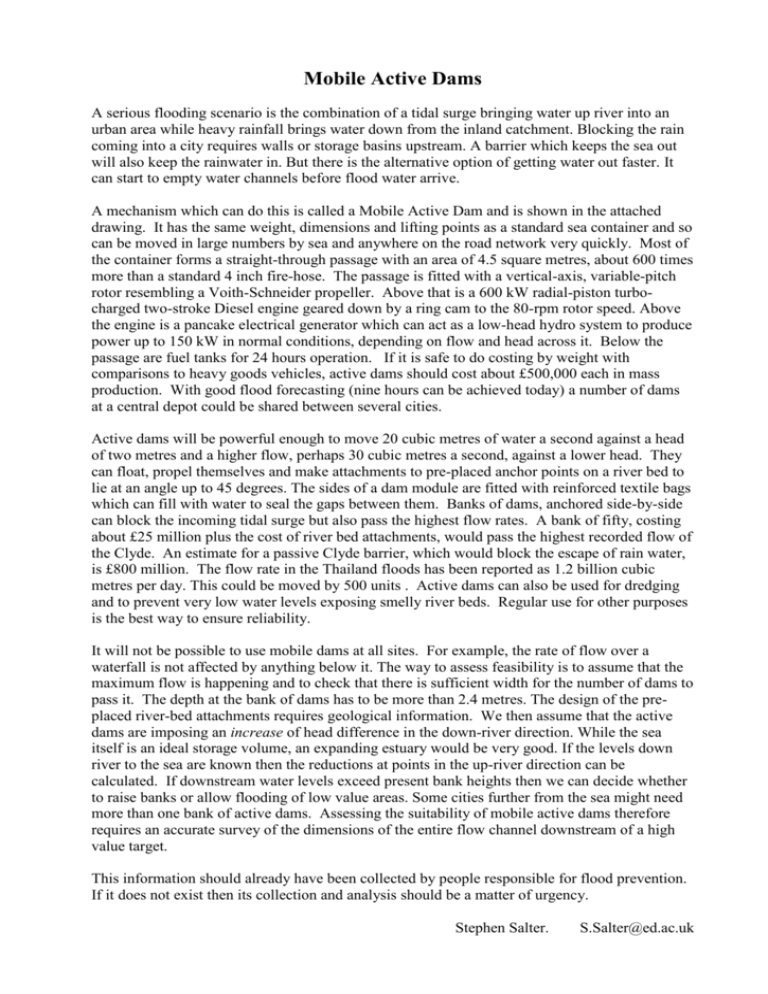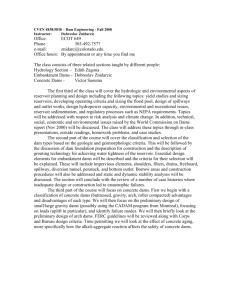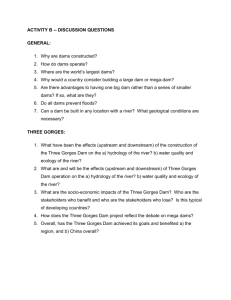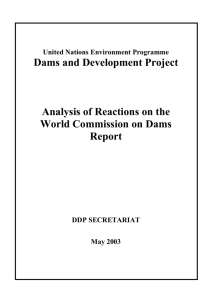Mobile Active Dams b..
advertisement

Mobile Active Dams A serious flooding scenario is the combination of a tidal surge bringing water up river into an urban area while heavy rainfall brings water down from the inland catchment. Blocking the rain coming into a city requires walls or storage basins upstream. A barrier which keeps the sea out will also keep the rainwater in. But there is the alternative option of getting water out faster. It can start to empty water channels before flood water arrive. A mechanism which can do this is called a Mobile Active Dam and is shown in the attached drawing. It has the same weight, dimensions and lifting points as a standard sea container and so can be moved in large numbers by sea and anywhere on the road network very quickly. Most of the container forms a straight-through passage with an area of 4.5 square metres, about 600 times more than a standard 4 inch fire-hose. The passage is fitted with a vertical-axis, variable-pitch rotor resembling a Voith-Schneider propeller. Above that is a 600 kW radial-piston turbocharged two-stroke Diesel engine geared down by a ring cam to the 80-rpm rotor speed. Above the engine is a pancake electrical generator which can act as a low-head hydro system to produce power up to 150 kW in normal conditions, depending on flow and head across it. Below the passage are fuel tanks for 24 hours operation. If it is safe to do costing by weight with comparisons to heavy goods vehicles, active dams should cost about £500,000 each in mass production. With good flood forecasting (nine hours can be achieved today) a number of dams at a central depot could be shared between several cities. Active dams will be powerful enough to move 20 cubic metres of water a second against a head of two metres and a higher flow, perhaps 30 cubic metres a second, against a lower head. They can float, propel themselves and make attachments to pre-placed anchor points on a river bed to lie at an angle up to 45 degrees. The sides of a dam module are fitted with reinforced textile bags which can fill with water to seal the gaps between them. Banks of dams, anchored side-by-side can block the incoming tidal surge but also pass the highest flow rates. A bank of fifty, costing about £25 million plus the cost of river bed attachments, would pass the highest recorded flow of the Clyde. An estimate for a passive Clyde barrier, which would block the escape of rain water, is £800 million. The flow rate in the Thailand floods has been reported as 1.2 billion cubic metres per day. This could be moved by 500 units . Active dams can also be used for dredging and to prevent very low water levels exposing smelly river beds. Regular use for other purposes is the best way to ensure reliability. It will not be possible to use mobile dams at all sites. For example, the rate of flow over a waterfall is not affected by anything below it. The way to assess feasibility is to assume that the maximum flow is happening and to check that there is sufficient width for the number of dams to pass it. The depth at the bank of dams has to be more than 2.4 metres. The design of the preplaced river-bed attachments requires geological information. We then assume that the active dams are imposing an increase of head difference in the down-river direction. While the sea itself is an ideal storage volume, an expanding estuary would be very good. If the levels down river to the sea are known then the reductions at points in the up-river direction can be calculated. If downstream water levels exceed present bank heights then we can decide whether to raise banks or allow flooding of low value areas. Some cities further from the sea might need more than one bank of active dams. Assessing the suitability of mobile active dams therefore requires an accurate survey of the dimensions of the entire flow channel downstream of a high value target. This information should already have been collected by people responsible for flood prevention. If it does not exist then its collection and analysis should be a matter of urgency. Stephen Salter. S.Salter@ed.ac.uk KEY NUMBERS FOR MOBILE ACTIVE DAMS (Note that Mathcad preserves all dimensions automatically). mm Suppose that rainfall RF 25 and that one mobile active dam can remove day 30 m3 Qdam sec The area that could be drained by each is Adrn Adrn 40.03 mile 2 This is a square of Sdrn Qdam 103.68 km2 or RF Adrn 10.18 km or Sdrn 6.327 mile Press reports are that that 62 pumps are at present moving Qnow 10 6 Rate per second is Qnow 11.574 m3 day m3 s Note ratio one mobile dam to present pumps Qdam 2.592 Qnow Press reports are that flooded area Afld 12 mile 2 or Afld 3.108 10 7 m2 If this is flooded to a depth of Zfld 1 m Afld Zfld and if there is no more rain the drain time is Tdrn1 31.08 day Qnow If we had a dam fleet of Ndam 50 the drain time is reduced to Afld Zfld Tdrn2 5.756 hr Ndam Qdam If container cross section is Acont 2.4 m 2.8 m 6.72 m2 Qdam m The water velocity at a nice Venturi exit is Uexit 4.464 Acont s kg If water density is w 1000 m3 1 The equivalent stagnation pressure is Pstg w Uexit 2 0.1 bar 2 1 Kinetic energy rate is Ekin w Qdam Uexit 2 298.9 kW 2 If water head is increased to H 1 m the potential energy rate is Epot Qdam w H g 294.2 kW Kinetic energy will be transferred to potential if we can get the exit well designed. Present choice of Diesel power is 600 kW. This could be increased if necessary by a small reduction of the height of the flow passage. The performance will be limited by internal cavitation where fluid passes through a throat of reduced area and by erosion of material at entrance and exit. The system is a very powerful tool and must be used with great care to avoid damage to river banks. We may need to reduce drive at the ends of a row and wind out geotextile to reduce erosion. We can also use them for dredging. If we set zero pitch and have electronics to convert the poly-phase generator to 3 phase 50Hz we can use the units for emergency generation.











